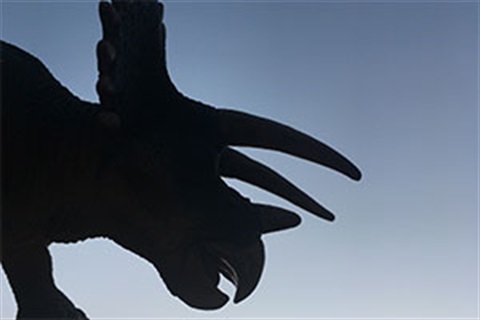Weld County's Tri-riffic History!
Published on June 03, 2021

The size of the tip of your thumb; that’s how big the bone was as it protruded from the ground. But what would have surely looked like a just small rock to the untrained eye, turned out to be a historic find – the first Triceratops skull found in Colorado. And it happened right here in Weld County.
Sure, bones of Triceratops had been discovered before. In fact, in 1887 a pair of horns, later determined to be those of a Triceratops, were found in Denver near present day Platte St. and I-25. Those horns are the first Triceratops remains ever found. And, of course, there were the Triceratops remains found during the construction of Coors Field in 1993. Triceratops, it seems, were once plentiful in what would have been tropical Colorado 65+ million years ago. But the Weld County find, well, that was special; that was the first skull.
Something else makes the fossil special: it has never been officially studied.
In 1982, University of Colorado Professor Kenneth Carpenter and his graduate assistant Emmett Evanoff (now Dr. Emmett Evanoff, Associate Professor of Geology at the University of Northern Colorado) had been in northern Weld County looking for small vertebrae fossils. They received permission from the individual living on the property (this becomes important later in our story), but had no luck on their original mission, so they decided to call it a day. As they were walking back to their car to leave, however, Dr. Carpenter happened to notice something sticking out of the ground – it was the size of the tip of your thumb. He called to Evanoff, and they started brushing away the dirt eventually revealing the skull of a young Triceratops.
The fossil was carefully removed and sent to the University of Colorado for reconstruction. As news of the discovery spread, a problem arose for the reconstruction team and the university. The fossil was found on private land, and the landowner had not given permission for its collection (the landowner had leased the land, and it was the lessee who told Carpenter and Evanoff they could be on the property). This point of fact plays into the exciting news the county is sharing today.
You see, the fossil was found on land owned by Mr. and Mrs. Roland Mapelli. Mapelli fought hard to retain ownership of the fossil, which he graciously gifted to Weld County with one special caveat: “it be displayed for the public in a County facility.” Because the fossil went from restoration to display, it has never been officially studied by paleontologists.
Enter into our story, Dr. Joe Sertich, Curator of Dinosaurs with the Denver Museum of Nature & Science. In January of 2018, Dr. Sertich sent an email to the county asking to discuss a possible arrangement: allow the museum to temporarily remove and study the fossil, and in return, the museum will restore the fossil (seems it wasn’t reconstructed quite right) and refurbish the display here in Weld County’s Administration Building. When the fossil is returned to the county in nine to 12 months), generations of Weld County residents will continue to be able to enjoy the historic find.
We are excited to announce today that both agencies are ready to move forward on this project, and we are taking you with us. Through regular updates in this newsletter, stories on our Discover Weld website, and new social media platforms dedicated to this project, Weld County and the Denver Museum of Nature & Science are excited to share regular updates on the fossil’s restoration. We also look forward to working with local experts here in Weld County to share other historic information about our home, such as the buffalo wallow in Windsor and the Dent Site in Milliken.
Weld County’s history, especially its ancient history, is fascinating, and we want to create platforms where everyone can learn and enjoy.
So stay tuned for the official launch of Pops the Triceratops – yep, that’s what the Weld County fossil was named – and let’s go on an amazing tour of Weld County’s past.
Learn more about Pops on the Pops the Triceratops webpage.